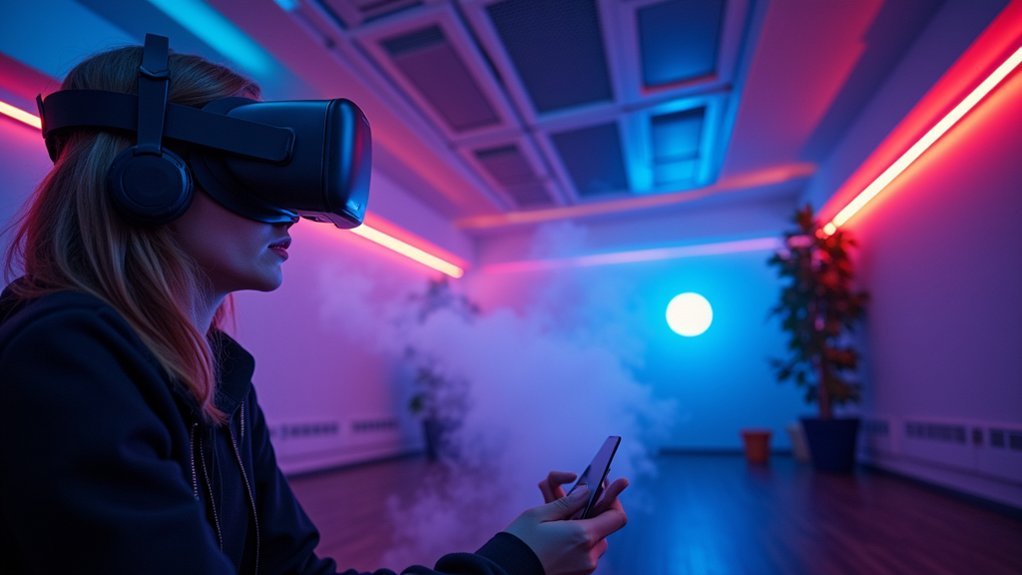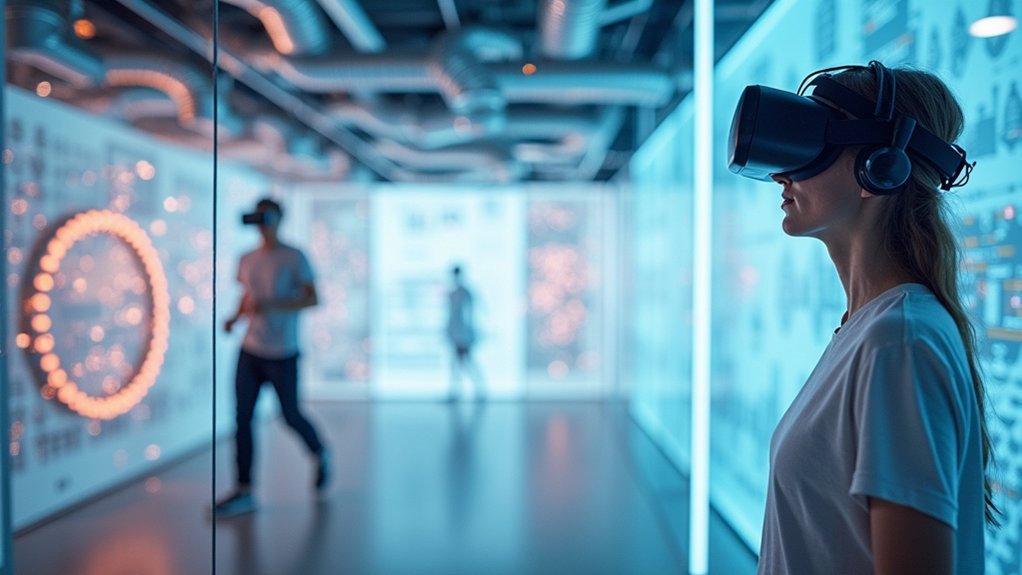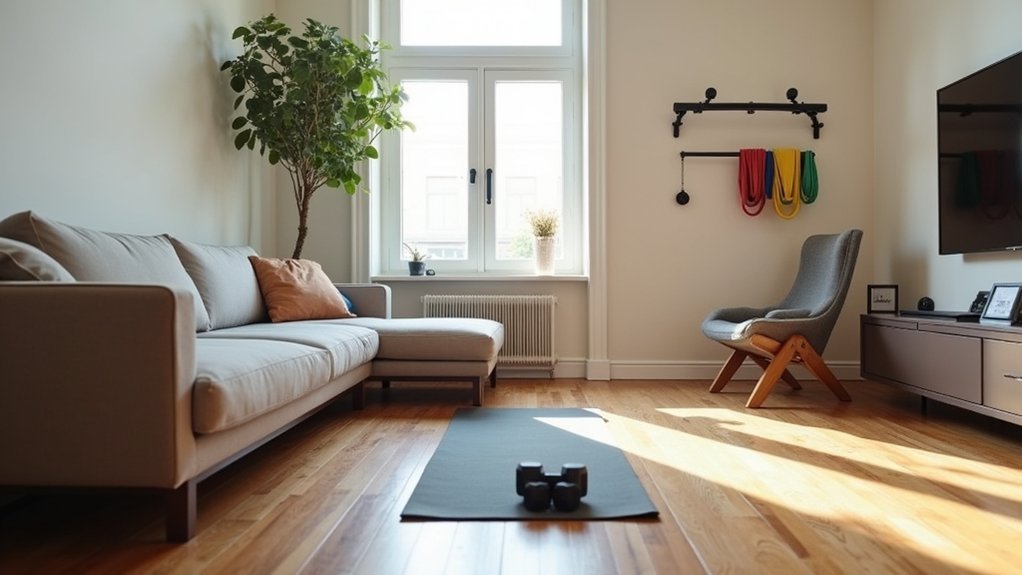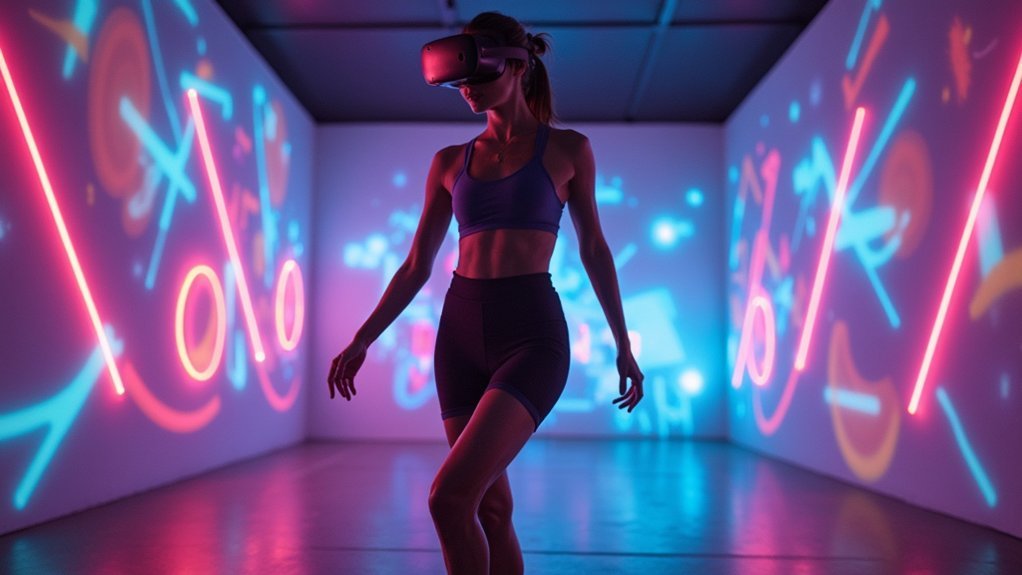You’ll need 30-50 CFM of airflow per user and 4-6 air exchanges hourly to maintain proper VR ventilation. Your space must stay between 68-72°F with 30-50% humidity to prevent equipment damage and user discomfort. Keep CO2 below 1,000 ppm since higher levels impair cognitive function and degrade your VR experience. Mechanical ventilation systems work best for consistent control, while noise levels should stay under 40 decibels to preserve immersion. The specifics depend on several additional factors.
Understanding Airflow Requirements for VR Gaming Sessions

When you’re immersed in an intense VR gaming session, your body generates substantial heat that can quickly turn your gaming space into an uncomfortable sauna.
Extended VR sessions generate intense body heat that transforms your gaming area into a sweltering, uncomfortable environment.
You’ll need at least 15-20 CFM of airflow per person to maintain proper ventilation and prevent stale air from accumulating around your play area.
Without adequate airflow, humidity levels spike dramatically, causing your VR headset lenses to fog up and destroying your immersion.
You should keep your gaming space between 68-72°F for ideal comfort during extended sessions.
Monitor your CO2 levels carefully—concentrations above 1,000 ppm will impair your cognitive function and reduce your gaming performance.
Proper ventilation isn’t just about comfort; it’s essential for maintaining the quality of your VR experience and preventing overheating.
Temperature Control in Dedicated VR Rooms
Three essential factors determine whether your dedicated VR room becomes a gaming paradise or an overheated nightmare: ambient temperature, equipment heat output, and air circulation patterns.
Your temperature control system should maintain temperatures between 68°F to 72°F (20°C to 22°C). This range prevents thermal throttling while keeping you comfortable during extended gaming sessions. Proper ventilation through air conditioning or exhaust fans dissipates heat from computers and VR hardware effectively.
Don’t overlook humidity levels – they’re equally important. Keep them between 30% and 50% to protect your electronic components and maintain comfort. Monitor both temperature and humidity regularly to catch issues before they impact performance.
- Install dedicated air conditioning with programmable temperature controls
- Use exhaust fans positioned near heat-generating equipment
- Deploy digital hygrometers for continuous humidity monitoring
Humidity Management During Extended Play Sessions

Extended VR sessions create a unique challenge that goes beyond basic temperature control – managing the moisture you generate through perspiration and breathing. Your body’s natural processes can quickly elevate humidity levels in enclosed spaces, creating discomfort and potentially damaging equipment through condensation.
Effective humidity management requires maintaining levels between 30-50% for ideal comfort. You’ll need proper ventilation systems that circulate air efficiently while expelling excess moisture. Installing a dehumidifier provides additional control, especially in rooms with limited air flow.
| Humidity Level | Comfort Rating | Equipment Risk | Action Required | Ventilation Need |
|---|---|---|---|---|
| Below 30% | Poor | Low | Humidify | Reduce exhaust |
| 30-40% | Excellent | Minimal | Monitor | Maintain current |
| 40-50% | Good | Low | Monitor | Slight increase |
| 50-60% | Fair | Moderate | Dehumidify | Increase intake |
| Above 60% | Poor | High | Immediate action | Maximum ventilation |
Real-time monitoring with hygrometers lets you adjust environmental controls instantly.
Natural vs. Mechanical Ventilation Systems for VR Spaces
While humidity control sets the foundation for comfortable VR sessions, you’ll need to choose between natural ventilation and mechanical ventilation systems to achieve ideal air circulation.
Natural ventilation uses passive airflow through windows and vents, relying on wind pressure and temperature differences. However, weather conditions can affect its consistency.
Mechanical ventilation employs fans and ductwork for active air circulation, giving you precise control over air quality regardless of external factors. You can also combine both approaches for optimal results, balancing energy efficiency with performance based on your VR space’s specific requirements.
- Natural ventilation: Cost-effective solution that works best in favorable weather conditions and properly oriented buildings
- Mechanical systems: Provide consistent airflow control and reliable air quality management year-round
- Hybrid approach: Combines both methods to maximize energy efficiency while ensuring ideal user comfort
Calculating Air Exchange Rates for Room-Scale VR Areas

Once you’ve selected your ventilation approach, you’ll need to determine the proper air exchange rates to keep your room-scale VR area comfortable and safe.
You should target 15-20 air changes per hour (ACH) for ideal air quality. For a standard 10×10 foot VR room, this means your ventilation system needs to move approximately 150 CFM to achieve 15 ACH.
You’ll want to adjust these rates based on user count and activity levels. More active VR sessions require higher air exchange rates.
Install CO2 monitors to track air quality—levels above 1000 ppm indicate insufficient ventilation.
Consider automated sensors that adjust your ventilation system based on occupancy and real-time air quality metrics for ideal performance.
Managing Heat Generated by VR Equipment and Users
When you’re setting up your VR space, you’ll need to identify all heat sources including headsets, base stations, computers, and the users themselves who generate around 100 watts each during active sessions.
Your cooling system must handle this combined heat load while maintaining the ideal 68-72°F range, which means calculating the total thermal output and selecting appropriately sized HVAC or exhaust systems.
You’ll also want to plan your airflow distribution carefully, ensuring cool air reaches both equipment and users while hot air gets efficiently removed from the space.
Heat Sources Identification
Since VR equipment and users both generate substantial heat during extended sessions, you’ll need to identify these dual heat sources before designing an effective ventilation system. High-performance VR headsets and gaming systems can reach temperatures up to 65°C (149°F), while users’ body temperatures increase by 1-2°C in confined spaces.
Understanding these heat sources helps you develop targeted ventilation strategies that address both equipment cooling and user comfort simultaneously.
- Equipment Heat Output: Monitor VR hardware temperatures during peak usage to determine cooling requirements for your specific setup.
- User Heat Contribution: Account for increased body heat and perspiration from users wearing headsets in enclosed environments.
- Ambient Temperature Control: Maintain ideal room temperatures between 20-23°C using smart sensors and proper airflow management.
Cooling System Requirements
Effective cooling systems form the backbone of any successful VR installation, requiring careful calculation of heat loads from both equipment and users to maintain peak performance.
Your cooling system requirements must include air exchanges of 4-6 times per hour to manage thermal buildup effectively. You’ll need active cooling solutions like HVAC systems or portable air conditioning units that can maintain temperatures between 68-72°F consistently.
Don’t overlook humidity levels in your planning—you must keep relative humidity between 30-50% to prevent equipment malfunctions and guarantee user comfort.
Monitor both temperature and moisture continuously, as VR sessions generate substantial heat from high-performance processors and active users.
Your air conditioning system should have sufficient capacity to handle peak loads during extended gaming sessions while maintaining ideal environmental conditions.
Airflow Distribution Strategies
Although cooling systems provide the foundation for temperature control, strategic airflow distribution determines whether you’ll successfully eliminate heat pockets that compromise both equipment performance and user experience.
You’ll need 30-50 CFM per user to maintain ideal conditions in your VR space. Position fans strategically around VR headsets and computers to disperse heat effectively, preventing dangerous hotspots that can damage expensive equipment.
Implement cross-ventilation techniques by creating designated equipment zones that separate heat sources from user areas. Your ventilation systems should focus on maintaining consistent air circulation throughout the entire space.
- Install temperature and humidity sensors to monitor real-time conditions and adjust airflow accordingly
- Position exhaust fans near heat-generating equipment while directing cool air toward user areas
- Create separate ventilation zones for high-heat components versus user comfort areas
Preventing Condensation on VR Headsets and Lenses
When humidity builds up in VR spaces, condensation quickly forms on headsets and lenses, creating foggy visuals that’ll ruin your immersive experience and potentially damage expensive equipment. You’ll need to control humidity levels through strategic environmental management.
Installing dehumidifiers greatly reduces moisture in the air, while proper ventilation using fans or air circulation systems disperses warm, humid air effectively. You should maintain at least a 15°F temperature difference between your headset and surrounding air to prevent condensation formation.
| Prevention Method | Effectiveness | Cost | Maintenance |
|---|---|---|---|
| Dehumidifiers | High | Medium | Low |
| Air circulation fans | Medium | Low | Very Low |
| Temperature control | High | High | Medium |
| Regular cleaning | Medium | Very Low | High |
| Ventilation systems | High | High | Medium |
Regular cleaning and drying after each session prevents moisture buildup completely.
HVAC Considerations for Multi-User VR Environments
As you scale up from single-user to multi-user VR environments, your HVAC system faces dramatically increased demands from both human occupants and equipment heat generation.
You’ll need specialized HVAC design that manages the substantial heat load while maintaining ideal air quality through proper ventilation systems.
Your multi-user space requires careful attention to carbon dioxide removal and contaminant control from prolonged user activity.
Following ASHRAE’s recommended air exchange rates guarantees sufficient ventilation for commercial VR setups.
You’ll benefit from implementing zoned HVAC systems that allow tailored temperature and airflow adjustments across different areas, accommodating varying user densities and activities.
Continuous monitoring of temperature and humidity levels becomes essential, as fluctuations directly impact both user comfort and VR equipment performance in your expanded environment.
- Install zoned HVAC systems for customized climate control in different VR areas
- Monitor temperature and humidity continuously to protect equipment and user comfort
- Follow ASHRAE air exchange rate guidelines for proper commercial space ventilation
Noise Levels From Ventilation Systems and VR Immersion
Beyond temperature and humidity management, your ventilation system’s noise output presents a significant challenge to VR immersion quality. When noise levels exceed 40 decibels, you’ll notice users struggling to maintain focus within virtual environments. This disruption triggers stress responses that diminish their overall experience.
| Noise Level (dB) | Impact on VR | User Experience | Recommendation |
|---|---|---|---|
| Below 30 | Ideal | Enhanced presence | Target range |
| 30-40 | Acceptable | Minor distraction | Monitor closely |
| 40-60 | Disruptive | Focus interference | Requires action |
| Above 60 | Poor | Significant disruption | Immediate fixes |
You’ll want to achieve noise levels below 30 decibels for ideal immersion. Effective soundproofing techniques like acoustic panels and strategically positioned ventilation ducts can dramatically reduce system noise, preserving the immersive environment your users expect.
Energy-Efficient Cooling Solutions for VR Gaming Rooms
You’ll need smart HVAC system integration that automatically adjusts cooling based on room occupancy and equipment load to maximize energy savings in your VR space.
Targeted airflow management solutions help you direct cool air precisely where it’s needed most, preventing wasted energy on cooling unused areas.
Heat load reduction strategies, including proper insulation and strategic equipment placement, can considerably lower your cooling requirements and operating costs.
Smart HVAC System Integration
When you’re running a VR gaming space, smart HVAC system integration transforms how you manage energy costs while maintaining ideal comfort levels.
Smart sensors continuously monitor occupancy, temperature, and humidity levels, automatically adjusting cooling output to match real-time conditions. You’ll achieve peak energy efficiency through automated scheduling that activates cooling only during peak gaming hours, reducing consumption by up to 30%.
Advanced zoning capabilities let you control temperatures in different areas separately, eliminating waste while maximizing comfort.
Variable refrigerant flow systems provide precise temperature control using considerably less energy than traditional HVAC systems. Smart sensors also track air quality and humidity, preventing equipment overheating and mold growth.
- Automated scheduling reduces energy consumption by up to 30% during off-peak hours
- Zoning capabilities provide separate temperature controls for different gaming areas
- Real-time monitoring prevents equipment damage and maintains peak gaming conditions
Targeted Airflow Management Solutions
Smart HVAC integration provides the foundation for thorough climate control, but targeted airflow management takes your VR space’s cooling efficiency to the next level.
You’ll need strategic solutions to combat the significant heat generated by VR equipment during extended gaming sessions. Ductless mini-split systems offer precise temperature control while eliminating energy waste typical of traditional HVAC systems.
These energy-efficient cooling solutions work best when combined with smart thermostats and sensors that optimize airflow based on real-time occupancy and equipment usage.
Strategically placed fans enhance circulation, ensuring cool air reaches every corner without excessive energy consumption.
Don’t overlook thermal barriers and wall insulation – they minimize heat gain and loss, creating a stable gaming environment while maximizing your targeted airflow management solutions’ effectiveness.
Heat Load Reduction Strategies
Beyond optimizing airflow patterns, reducing your VR room’s overall heat load represents the most cost-effective approach to maintaining comfortable gaming temperatures.
You’ll achieve significant energy savings by upgrading to high-efficiency air conditioning units, which consume 30% less energy than standard models while delivering superior performance.
Proper insulation and gap sealing prevent unwanted heat infiltration, while smart thermostats optimize cooling schedules based on your gaming patterns.
You can enhance air circulation using ceiling or portable fans, distributing cool air more evenly throughout your space.
- Install thermal curtains or window films to block solar heat gain from windows
- Implement energy-efficient cooling systems with programmable HVAC controls for automated temperature management
- Combine strategic insulation improvements with enhanced air circulation to reduce overall cooling demands
Heat load reduction strategies guarantee sustained comfort during intensive VR sessions.
Ventilation Safety Standards for Commercial VR Facilities
Since commercial VR facilities host multiple users throughout the day, they’re required to meet stringent ventilation safety standards established by ASHRAE and OSHA.
These organizations mandate specific air exchange rates to maintain indoor air quality and prevent carbon dioxide buildup during extended gaming sessions.
You’ll need to provide at least 15-20 cubic feet per minute of outdoor air per person to meet compliance requirements. This prevents exposure to indoor pollutants while ensuring user comfort throughout their VR experience.
Regular monitoring becomes essential for your facility’s success. You must track CO2 levels and humidity to maintain safety standards.
Implementing a balanced ventilation approach combining mechanical and natural systems will help you achieve ideal air quality while improving energy efficiency and reducing operational costs.
Frequently Asked Questions
Do Crawl Spaces Need to Be Vented?
You shouldn’t vent your crawl space. Modern building science shows vented crawl spaces increase moisture problems, promoting mold growth and structural damage. Instead, you’ll get better results by sealing vents and encapsulating the space.
Are Crawl Space Vents Required by Code?
You’ll need to check your local building codes since requirements vary by municipality. While many areas historically required crawl space vents, some jurisdictions have updated codes to allow sealed, encapsulated crawl spaces instead.
Do Crawl Space Vents Help With Radon?
Crawl space vents don’t effectively reduce radon levels. You’ll get better results sealing vents and installing vapor barriers. The EPA recommends sub-membrane depressurization systems rather than relying on ventilation for proper radon mitigation.
Can a Crawl Space Be Unvented?
Yes, you can create an unvented crawl space through encapsulation. You’ll seal all vents and install vapor barriers on walls and floors, which controls moisture better than traditional vented spaces.
In Summary
You’ll need proper ventilation that balances airflow, temperature, and humidity while minimizing noise disruption to your VR experience. Whether you’re setting up a home gaming room or commercial facility, calculate air exchange rates based on occupancy and heat generation. Don’t overlook energy efficiency when selecting cooling solutions, and make certain you’re meeting safety standards for multi-user environments. Your ventilation system should enhance comfort without compromising immersion quality.





Leave a Reply